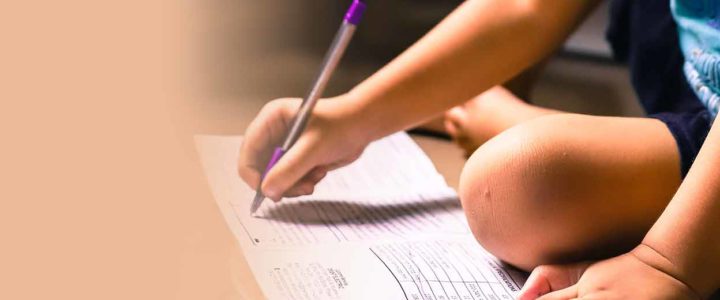It’s not simple or easy to determine if a child has a learning disability. Many otherwise normal behaviour can sometimes be misidentified for being a learning disability.
A child with poor attention span and focus, or someone who regularly disrupts class is sometimes used as an indicator of a possible learning disability. A child with issues socialising with their peers can also indicate this. These can all be indicators but not necessarily mean anything. It’s very possible that disruptive children with poor attention spans are just children who are misbehaving. A bored child can also act up in class, and not all children are sociable. Socialisation is a skill that has to be taught, typically.
The best way to determine if the child has a learning disability is to get a professional assessment. There are just too many symptoms that look perfectly normal and too many normal symptoms that could point to it being a learning disability. A proper diagnosis will lead to the child getting proper intervention, and the appropriate education plans to help them cope with their particular learning disability.
The most common learning disabilities are:
Attention Deficit/Hyperactivity Disorder (ADHD)
This affects millions of children and is one of the most common. Children affected by ADHD have difficulties focussing, paying attention in class, and may also be hyperactive. This makes it difficult for them to sit still for prolonged periods as they are too physically and mentally distracted. Children who go undiagnosed often grow into adulthood with ADHD, where it may affect them professionally. ADHD is effectively treatable with behavioural therapy and appropriate medication.
This affects millions of children and is one of the most common. Children affected by ADHD have difficulties focussing, paying attention in class, and may also be hyperactive. This makes it difficult for them to sit still for prolonged periods as they are too physically and mentally distracted. Children who go undiagnosed often grow into adulthood with ADHD, where it may affect them professionally. ADHD is effectively treatable with behavioural therapy and appropriate medication.
Dyscalculia
Dyscalculia affects up to 7% of all students and is more difficult to diagnose than Dyslexia because it tends to exist alongside other conditions like ADHD, and treating these other conditions can sometimes diminish the effects of Dyscalculia. Young students with Dyscalculia may have difficulties reading numbers and understanding its connection to quantity. They may have difficulties performing basic addition and subtraction and the condition may persist into their teen years.
Dyscalculia affects up to 7% of all students and is more difficult to diagnose than Dyslexia because it tends to exist alongside other conditions like ADHD, and treating these other conditions can sometimes diminish the effects of Dyscalculia. Young students with Dyscalculia may have difficulties reading numbers and understanding its connection to quantity. They may have difficulties performing basic addition and subtraction and the condition may persist into their teen years.
Dysgraphia
Children who have trouble expressing themselves in writing may have a condition known as ‘Dysgraphia’, or impaired writing. The most obvious signs are struggling to differentiate between upper and lower case letters and difficulties with written expression of ideas and thoughts, resulting in a bad composition. For children with dysgraphia, the writing process is challenging and slow, thus affecting their overall understanding in class. Seeking professionals or therapists can help to alleviate the severity of dysgraphia.
Children who have trouble expressing themselves in writing may have a condition known as ‘Dysgraphia’, or impaired writing. The most obvious signs are struggling to differentiate between upper and lower case letters and difficulties with written expression of ideas and thoughts, resulting in a bad composition. For children with dysgraphia, the writing process is challenging and slow, thus affecting their overall understanding in class. Seeking professionals or therapists can help to alleviate the severity of dysgraphia.
While specific learning disabilities may be common, there are still many children that go undiagnosed. As a result, they suffer academically, affecting their future prospects and opportunities as well as impacting their self-esteem. Once these children reach adulthood, their unaddressed learning disabilities still exist and may present itself in various ways to make personal and professional life difficult to manage.
In many cases, there are effective treatments and therapy that may be available. Having the child properly assessed as early as possible, is the first important step to ensuring they received the appropriate help they require.
College of Allied Educators offers our Diploma in Learning Disorders Management & Child Psychology programme to help you understand your child or the child in your care to more effectively help in their learning and development.
What will you gain from this programme?
- Identify specific disabilities and understand the diagnosis and assessment of individual weaknesses
- Acquire a strong foundation in speech and language development, child psychology, abnormal psychology and counselling.
- Develop a range of teaching skills to suit the needs of your child or the child being taught
- Learn to work with educators and therapists to provide counsel and support to families and parents of children with special needs
The Diploma in Learning Disorders Management and Child Psychology can be completed in 6 or 12 months, part-time.
To find our more, and for a FREE COURSE PREVIEW
CALL US at 6533-0031 EMAIL your enquiry to MELISSA.TAN@ICAE.EDU.SG
or Register for your free preview below:

